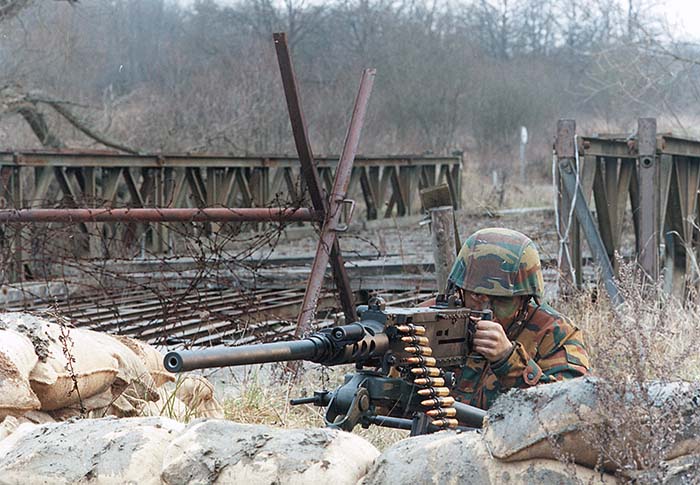By Robert Bruce
John Moses Browning’s .50 caliber machinegun first roared to life in the closing month of World War One. Astonishingly, it is still in first line U.S. service and with many other armies worldwide today, nearly eighty years later. Although heavy, a bit cantankerous, and really fussy about headspace, the M2 Heavy Barrel Machine Gun is rightly considered by many to be the best in its class. “Ma Deuce” as she has been affectionately known by generations of American military men, is still an indispensable member of the modern small arms family and will remain so well into the new millennium.
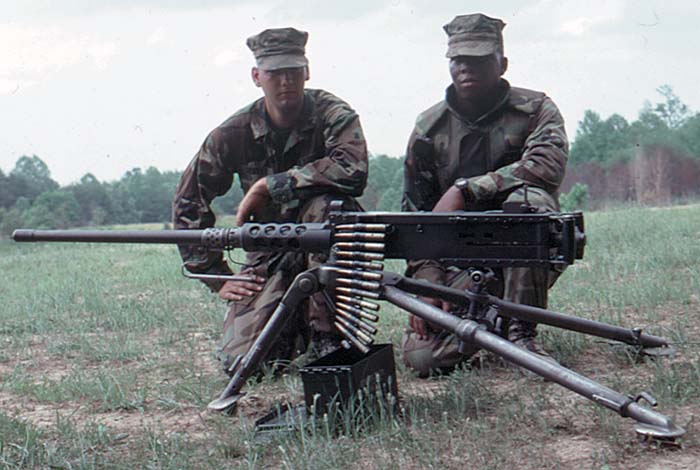
Introduction to Part 2
Last month in Part One we explored the developmental history of John M. Browning’s famous .50 caliber M2HB machine gun and its ground, sea and air combat use from WWII through Vietnam. Now, we continue our in-depth study of Browning’s masterpiece, visiting a unit of today’s US Marines as they introduce some of their newest officers to the oldest and longest serving infantry weapon in the American arsenal. Quantico, Virginia is the center of the Universe for the United States Marine Corps and home of its Officer Basic School where newly commissioned Marine lieutenants go for a tough and uncompromising introduction to the most fundamental missions of the Corps. Among the many rich and varied experiences that these young officers will have during their stay at Basic is the opportunity for some hands-on live fire with the family of Marine Corps small arms. Captain George Schreffler, Range 7 OIC for the day, has kindly consented to allowing close in photographs during the day’s training and firing. Wisely, he places me with Sergeant Mayc-o McKeever and his men from Weapons Platoon, CI Company. McKeever, a no-nonsense guy as you might well expect, makes sure I get the opportunity for the full experience by thoughtfully providing a ten pound kevlar flak vest and helmet. This is a real treat and immediately makes me feel just like one of the boys; sweating like a pig on a typically hot and humid southern summer day with the nearest shade some 25 meters behind the firing line. Are we having fun yet?

Role Reversal
One of the day’s unexpected delights for this old retired Army sergeant was the opportunity to see some real Marine NCOs in firm control of some nearly real Marine lieutenants. This seems to be one of those fascinating and little known traditions of the Corps that when young officers are in student mode — which they definitely are at Basic School — the staff is in charge. And there was no doubt that day at the .50 caliber station on Range 7 that Sergeant Mayc-o McKeever, Sergeant Grisson Gamba, and Corporal Tom Senter were clearly in charge. The lieutenants had already spent several days in classroom instruction on tactical theory of crew served weapons and practical mechanical training with stripping, cleaning, assembling and adjusting both the Mark 19 grenade machine gun and the M2 fifty cal. After yet another opportunity that morning to break ‘em down and put ‘em back together, several groups of about twenty made their way in round-robin fashion from live fire stations on these two guns as well as an AT4 subcaliber launcher.
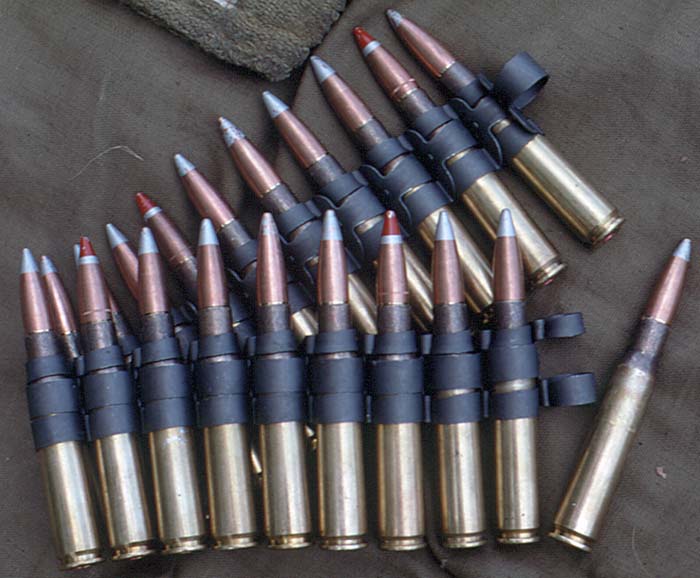
Ammo Point
Their first stop along the way to visiting Grandma Deuce was the ammunition shed, where each Marine was issued a short belt of cartridges — and I mean a SHORT belt. Given the pitiful state of today’s pathetically shrunken military budget and grossly accelerated operational tempo, the Corps can’t afford to give their soon-to-be-real lieutenants more than twenty rounds apiece without dangerously shortchanging forward-deployed Marines! Meanwhile, Clinton seems to think it is fine to give billions to Boris Yeltsin’s Russian kleptocracy and congress seems to consider funding day care centers for unwed military mothers and other politically correct bullshit to be a higher priority. May God help us in any coming wars….(Editor’s note: At this point, the author goes off on a political rant that we decided to spare the readers, who will probably agree with Robert, but we HAD to keep his admonition regarding training ammunition budgets intact- Dan ) Everybody got some pretty spectacular 1991 production Lake City stuff. Each belt featured a regular series of four rounds of M8 API (armor piercing incendiary) plus one M20 APIT (armor piercing incendiary tracer) strung out on M9 metallic links. The M8 is a real crowd pleaser because it produces a very bright flash on impact, giving the gun crew unmistakable evidence of where the rounds are hitting. It also does a particularly nasty bit of work on lightly armored enemy vehicles such as the Soviet BMP and the troops inside.
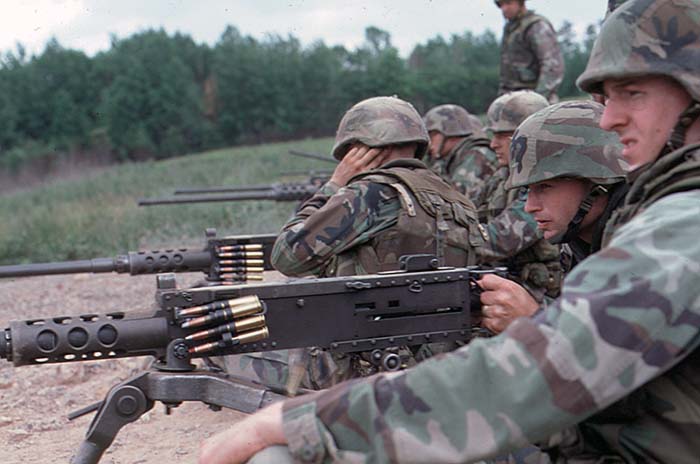
Listen Up, Sir!
A short walk down the hill brought them to the .50 cal. station, where they gathered in front of Sergeant McKeever who gave them a quick set of do’s and don’t’s. You know the drill: “Welcome to the M2 .50 caliber heavy machine gun station where you will have the opportunity to engage targets at extreme range,” McKeever began with well-practiced professionalism. His five minute refresher course succinctly covered the process of using the rear sight to “dial in” estimated range, then firing short bursts to observe the strike of cartridges in the beaten zone. “Remember your WERM formula exercises (Width Equals Range times Mils),” McKeever sagely offered, helpfully adding that each click of the “T&E” (traversing and elevating mechanism) only moves the gun’s aimpoint one mil (roughly one meter up/down/left/right for each thousand meters of range). Initial manipulation of the T&E, he coached, was best done in increments of five or more clicks with the loader/observer for each two man team specifying how many clicks to the gunner. Noting that the ammunition they had been given consisted of strings of four incendiary rounds followed by a tracer, McKeever took pains to caution them that they should not rely on the apparent path taken by tracers as this gets deceptive at relatively long range. “Watch the dust and flash from your burst,” he cautioned, “that’s where most of the steel is hitting.” Sergeant McKeever concluded his rapid fire refresher with two time-honored and obligatory phrases: “DON’T DO ANYTHING until you are told to. Any questions?” He broke the group down into pairs and put the first set on the ground behind six guns ready on the firing line, then led them step by step through loading drill. The most amusing aspect of this came at the point when feed covers were slammed down to lock and it became necessary to retract the bolt. This is a man’s job, requiring a hefty jerk of the retracting slide handle to not only overcome tension of the gun’s beefy recoil spring, but also to pull the first round out of its snug metal link. Amusingly, more than one lieutenant (probably headed for staff duty) wasn’t able to do this without a struggle. Finally, satisfied that everybody was ready, Sergeant McKeever gave the order to commence firing.
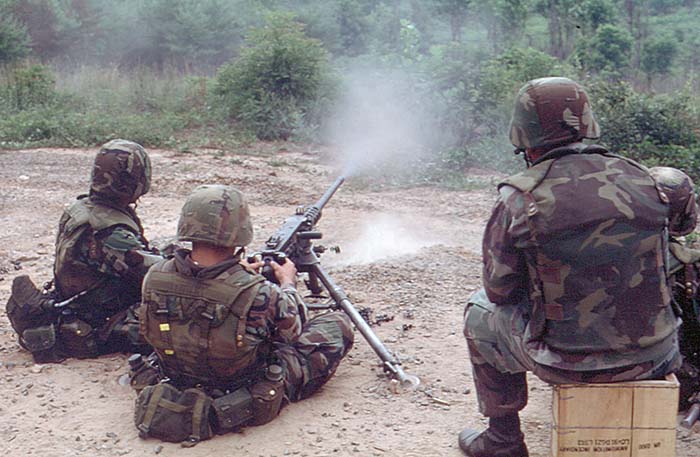
Despite McKeever’s broad hint that it might be far more efficient to first lift the very precise leaf rear sight and adjust range before firing, many of the gunners seemed content to use only the battlesight aperture, with its fixed range at about 500 yards. The guns boomed to life in fits and starts as each two man crew got their first fifty cal. experience, immediately drawing appreciative comments from those behind who were awaiting their turn. Ma Deuce is a two-fisted handful of machine gun and her noise, dust, range and hitting power combine for an awesome experience. Even those who had just come from the 40mm grenade machine gun station were impressed by the M2’s earplug-packing blast and the graceful flight of tracers followed by eruptions of flash, dust and smoke near the derelict tanks and other vehicle targets set on a ridgeline some 1000 meters away. Trying hard to remember which way to turn the T&E handwheels for the desired correction (the elevating handwheel is turned counterclockwise to raise the muzzle and putting the left thumb on the traversing handwheel and pushing it over the top moves the muzzle to the right), each crew did its best to adjust their gun so that successive bursts would walk closer and closer to the target. It doesn’t take long for each to go through his pitiful 20 rounds, and I don’t doubt that many would have pulled out their wallets to buy more M2 time if an ammo dealer had been there. (I hope I haven’t just given SecDef Cohen any ideas) Loader/observers and gunners switched places and went through the same exercise with essentially the same results. After the second set of Marine officers had their turn I was treated to an amazing sight as they all bent over and started to police up their own brass and links! Is it rude to speculate that this will probably be the only time in the rest of their service with the Corps when this will happen?

Combat Arms Track
To be fair, the Basic School curriculum is not designed to turn out fully trained Marine infantry officers, but in this case to give new lieutenants who will be going to any specialty of the Corps — including supply, administration, medical and even legal assignments — a brief introduction to combat weaponry from pistols to antitank rocket launchers. You had best believe that there is a lot more hands on time with all of the Corps’ small arms and other weaponry in store for those officers and enlisted Marines who will be assigned to the infantry and other direct combat specialties.
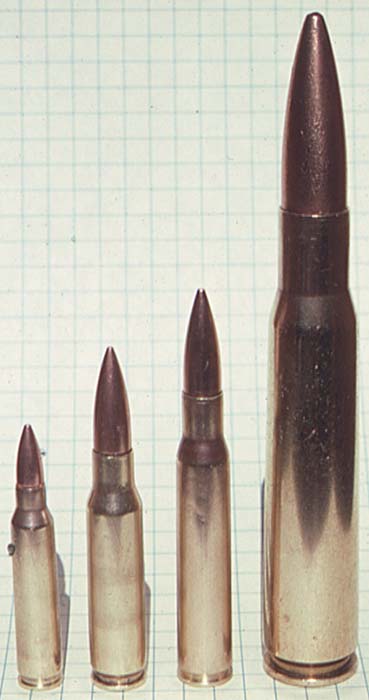
As tough and capable as the M2HB was and is, it can also be quite cantankerous and very picky about its mechanism. This is no weapon for those who are indifferent to maintenance or unskilled in mechanical principles. Not even John Browning could make her “idiot proof” and woe unto those who stupidly neglect to keep her clean and oiled, and who don’t regularly attend to the twin bogeymen known as headspace and timing. So, Browning made these fully adjustable in order that barrels, receivers and their working parts from many different sources could be made to work safely and efficiently. To help make sure these adjustments are precisely made anytime and anywhere, Uncle Sam provides a handy and indispensable tool with every gun. Not surprisingly, this is called the Headspace and Timing Gauge and it’s the key to avoiding a world of hurt.
Failure to properly set headspace and timing can lead to severe damage to the gun as recoiling parts batter against one another or lead to blown and separated cases with catastrophic results including having the gun literally explode in your face! Keeping this in mind, let’s take a look at the following series of photos demonstrating just exactly how these adjustments are correctly done.
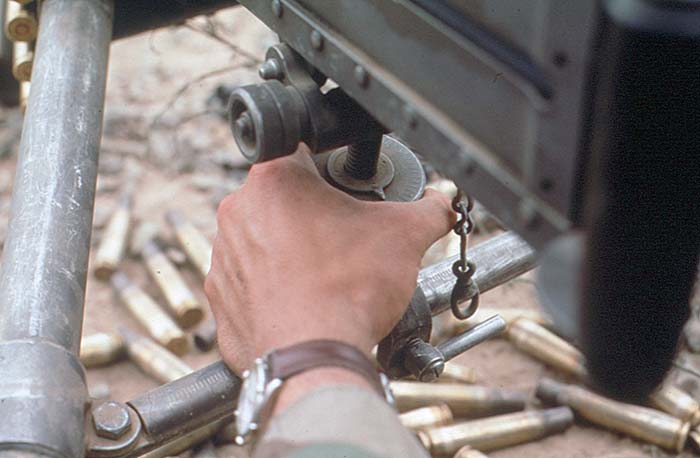
Field Stripping
The M2 must, of course, be taken apart for a thorough cleaning after firing. This is no big deal since the major groups are big and easy to grab hold of and John Browning made sure that you would be able to do this with no special tools. Two very important considerations before stripping begins are to clear the gun and to make sure the bolt is fully forward. The reason for the first should be obvious, but the second ensures that the powerful driving spring rod assembly is decompressed and won’t fly out and drill a hole in your skull when removing the backplate. Don’t let your widow say I didn’t warn you.
While we take Ma Deuce apart for mandatory maintenance, let’s also examine her vital organs and marvel at the mechanical genius of John Browning.
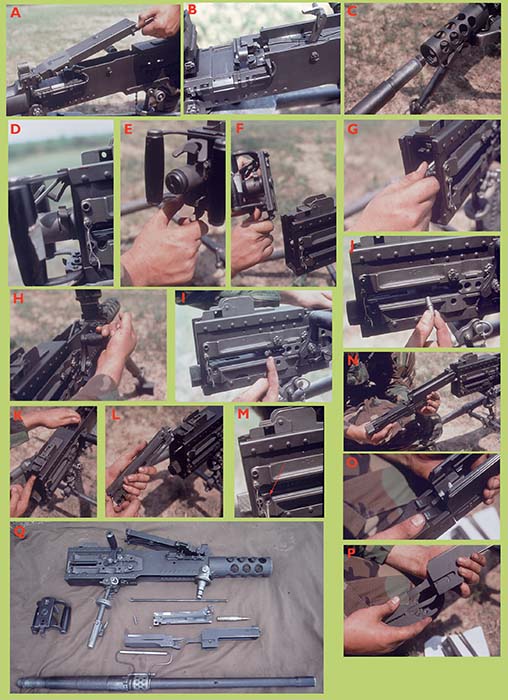
A: The first step is always to unload and clear the gun. Raise the feed cover, retract the bolt, ensure the chamber is clear then allow the bolt to run fully forward.
B: Unscrewing the barrel requires that the barrel locking spring lug be aligned with the 3/8 in. hole in right sideplate. This is usually accomplished by placing a small link loop between the trunnion and the front of the barrel extension. However, with this particular gun, it was necessary to use the large loop. Go figure….
C: The barrel can now be unscrewed either by hand or with the help of the handy built-in wrench in the barrel carrier assembly. Notice how the barrel flares out larger just forward of the chamber providing more metal mass as a heat sink for sustained firing.
D: A side view of the backplate shows the sheet metal clip around the buffer tube sleeve that serves as the bolt latch release lock. This can be rotated up to hold the bolt latch release (center trigger between wings of the “butterfly” main trigger.
E & F: MAKE SURE THE BOLT IS FULLY FORWARD before removing the backplate. This relaxes the very powerful driving spring rod assembly so that it won’t punch a hole in you when unseated. Unlatch the backplate and lift it up and out.
G: Remove the driving spring rod by pushing in and to left, then pull the whole driving spring assembly out the rear of the receiver. This powerful mechanism drives the bolt and other recoiling parts forward to lock and fire.
H, I & J: Begin removing the bolt by first yanking the retracting slide handle rearward to free the bolt from the barrel extension. Continue pulling rearward until the bolt stud lines up with the hole on right of sideplate, allowing it to be pulled out.
K: The trigger bar is in the way of the bolt and must be pushed up as the bolt is slid rearward and out of the receiver.
L: Take care to grasp the extractor so it won’t become unseated as the bolt clears the receiver wall. Place the bolt down on its right side with the extractor up.
M & N: Begin to remove the barrel buffer and barrel extension groups by pushing a suitable small tool thru the hole in the lower rear corner of the right sideplate to unlock barrel buffer body. There’s a drift pin on the combo tool just for this purpose, but the screw end of a cleaning rod or point of a bullet works just fine. At same time, use one hand in the receiver to push the barrel extension/buffer group to the rear and remove. Keep in mind that in operation, this assembly plus the bolt and barrel are locked together on firing then recoil a short distance before unlocking. There is a lot of steel there for recoil forces of each exploding round to move.
O & P: Unlock and separate the groups by pushing the tips of the accelerator.
Q: Layout of major parts and assemblies after field stripping (top to bottom, left to right): receiver group with pintle and T&E attached, backplate, driving spring rod assembly, bolt stud, bolt, dummy cartridge, barrel buffer, barrel extension, and barrel assembly.

All Clear!
Making sure the M2 is clear after a firing session can be a bit tricky as well, particularly with a very hot gun and rounds remaining in the belt. This can lead to “cookoff” which can occur when a chambered round in an overheated barrel spontaneously detonates. It is wise to point the gun in a safe direction and allow it to thoroughly cool before attempting to unload, or use the bolt latch release lock to capture the bolt in its rear position for free circulation of air through the barrel. The first step is to unlock the feed cover and lift the belt out of the feedway. Since the gun will fire with the feed cover up it is important to keep away from the trigger butterfly until the bolt can be retracted. The gunner then pulls the bolt fully to the rear which should extract the chambered round and cause it to drop harmlessly onto the ground. The bolt can be locked rearward with the bolt latch, allowing examination of the chamber to ensure it is clear.

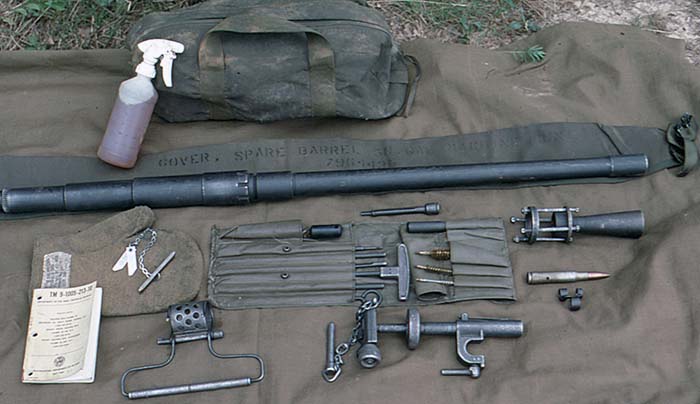
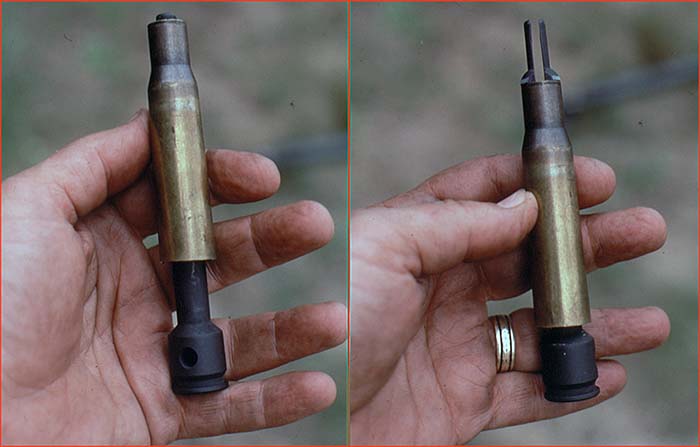
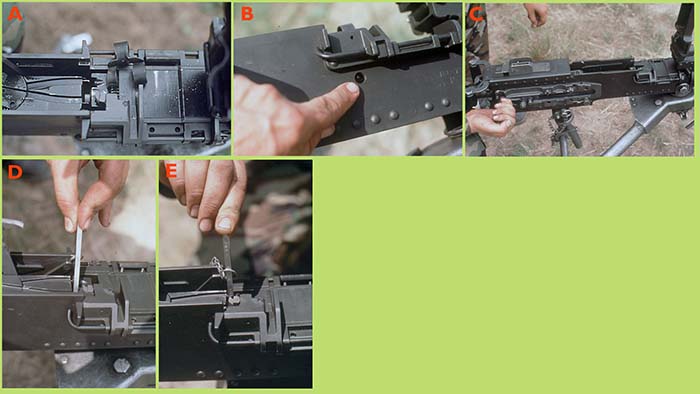
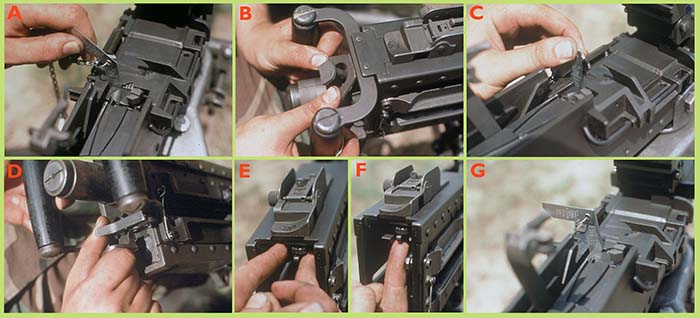
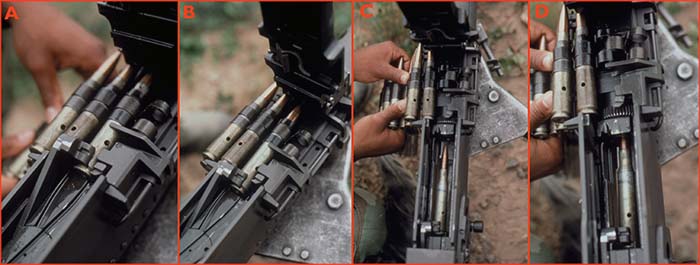
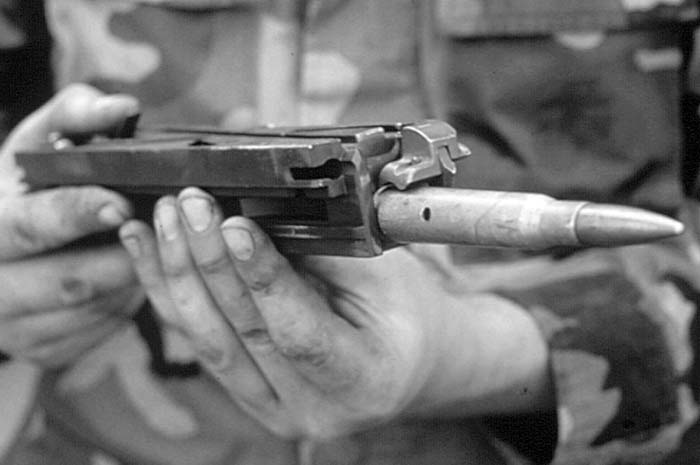
| This article first appeared in Small Arms Review V3N5 (February 2000) |



